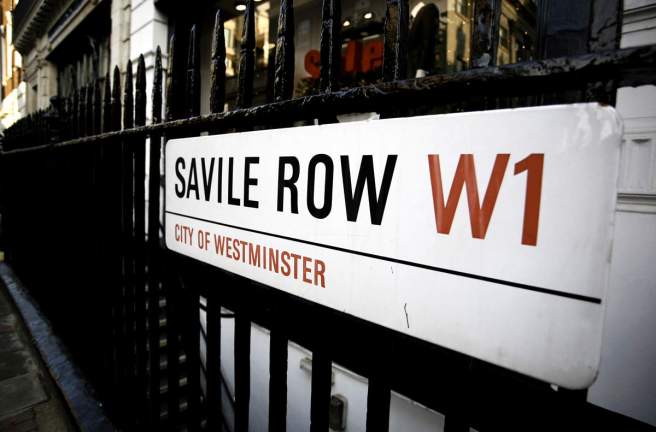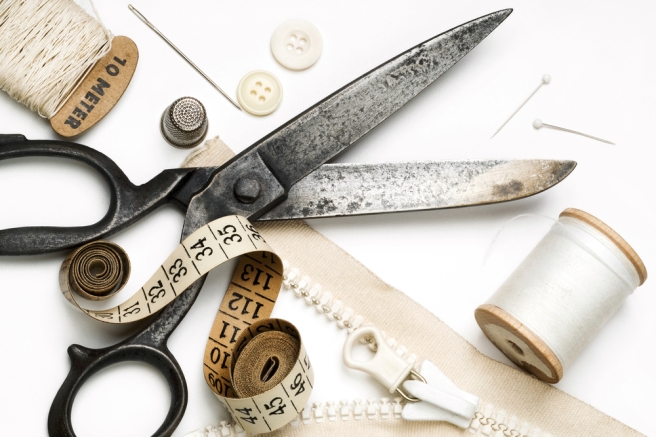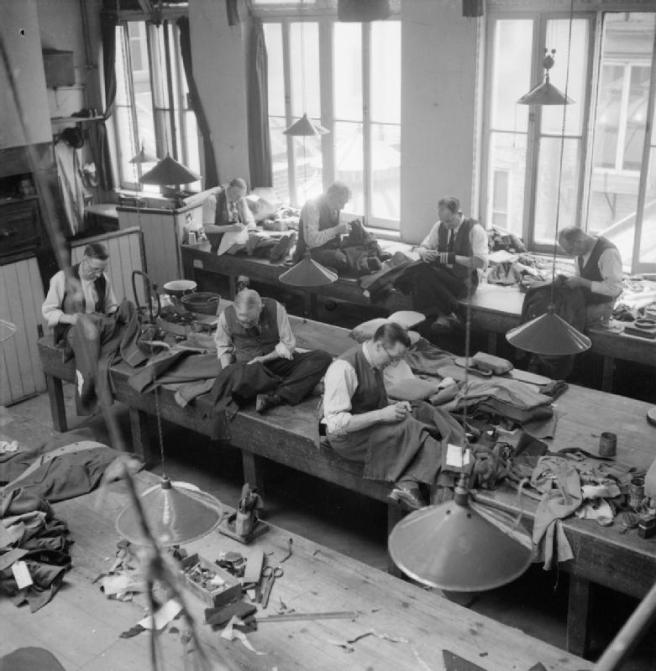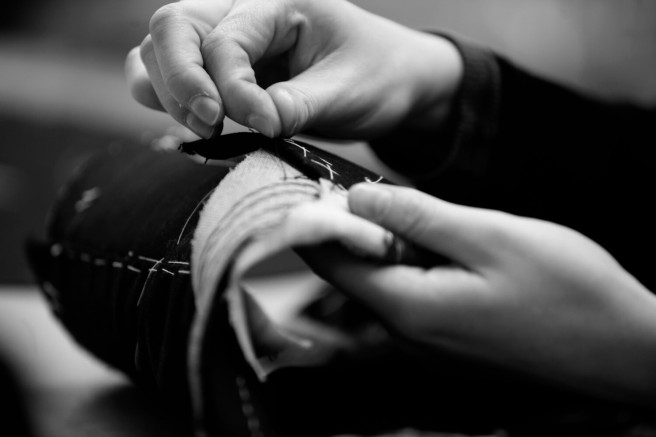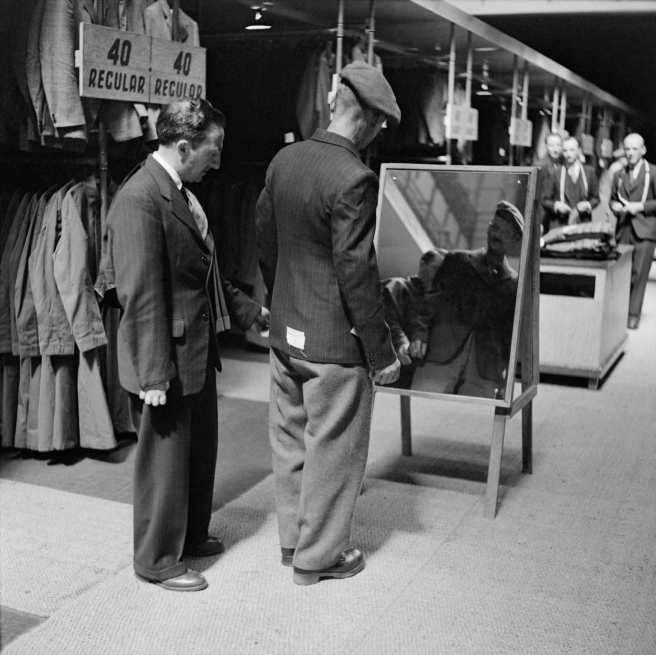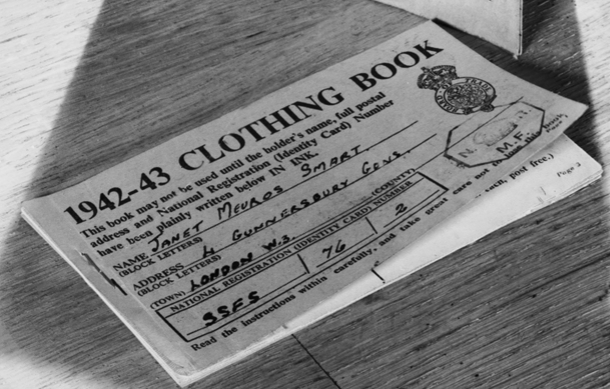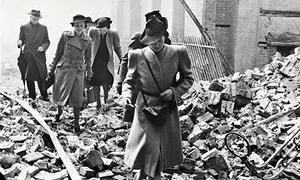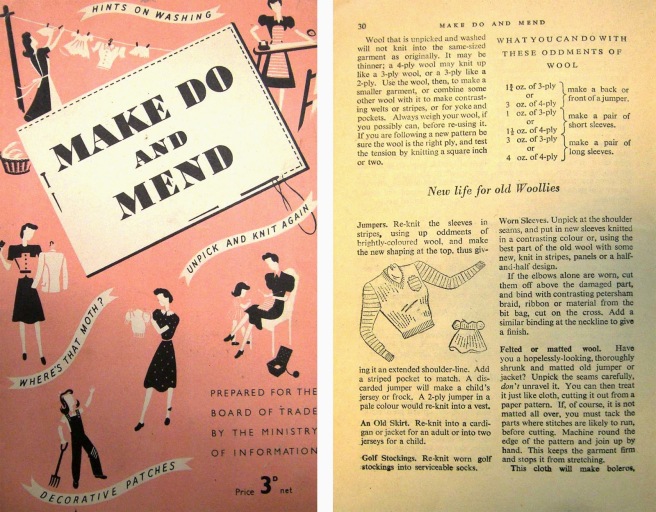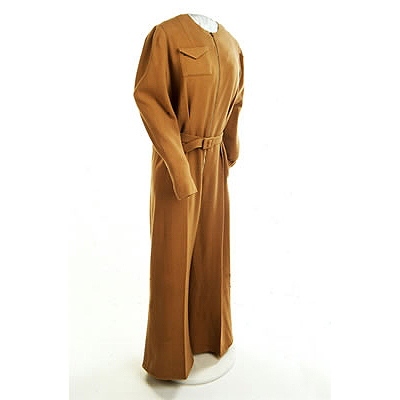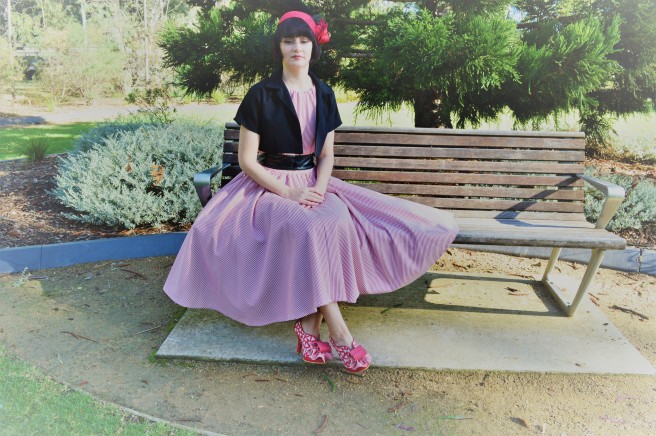
I have been in the world of fashion now for fifteen years and the only thing that is consistent is that it is forever changing. Fashion evolves from one season to the next, from one decade to another, and then we see it come full circle with trends we once loved, being revived with a modern twist and fresh direction. My own tastes in fashion have changed over the years, and I have certainly been influenced by what other designers are doing. Throughout this time I have never lost my passion for this beautiful form of art. I have always been and will remain a strong advocate for fashion, the freedom it can provide you and the creativity that it inspires. Recently I decided it was about time that I make some of my work accessible, and to showcase to everyone what I do and why I love it so much. In this blog you will discover some of my favourite pieces that I designed and produced, with professional photographs of me getting my vogue on to show the world who Anastacia Rose really is, and just what she’s capable of. So I hope you follow on and enjoy this insightful journey into my own realm of fashion and all that shines within.
Outfit One “My Fair Lady” – Inspired by the fabulous fashion era of the nineteen fifties, this ensemble would have to be my favourite. Now I know a mother is not supposed to favour any of her children, but this one just edges out all of the others! I found a vintage Butterick pattern for this dress in my local haberdashery and instantly fell in love. The nineteen fifties has always been one of my favourite eras of fashion, with its full skirts, nipped in waists and overall feminine outlook. The dress in constructed with a self-lined bodice that gathers on a yoke at the neckline and forms a scoop back. With an exaggerated waist due to the fullness of the skirt below, this dress bellows out to fall at mid-calf. The skirt is a full circle, with an attached petticoat constructed from five meters of netting. The main fabric that I used is a cotton blend with a textured red and white stripe. I think the fabric adds to the dramatic look of the outfit, with the different angels of the stripe inducing intrigue in the eye of the onlooker. My Fair Lady is accompanied by a crop jacket with a dolman sleeve and collar. Accessorised on this occasion by a wide leather belt that ties into a bow at the centre back. Also complementing the outfit, is a millinery creation consisting of a plaster skull cap covered in vibrant red silk. Accented by a black ostrich feather and hat veil, the piece title “Anastacia”, is a tribute to the great art of millinery and one of the very first pieces that I ever made. Completing the outfit are the stunning shoes from Irregular Choice which while they may not be all that practical to walk in, come up looking a treat when photographed! My Fair Lady is an outfit that I love to wear, and have done so to local Fashion on the Field events and also to a wedding. It is everything that I love about this industry. It shows my true character and love for all things vintage.
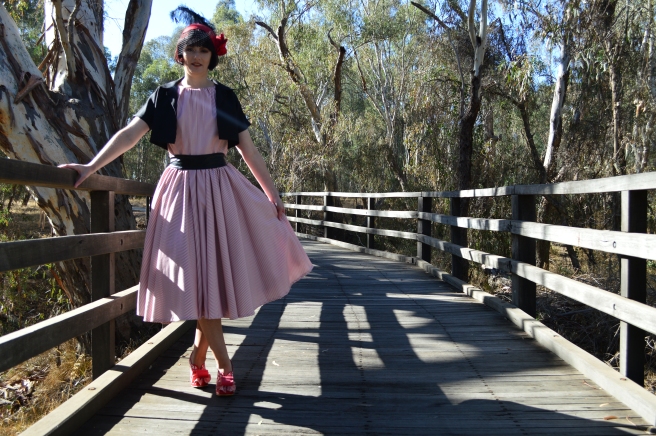
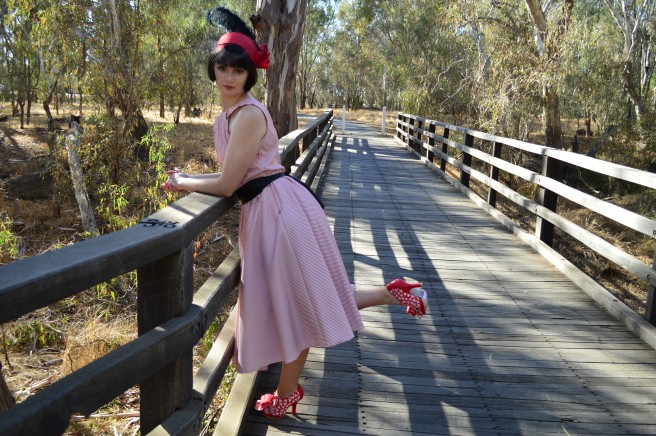
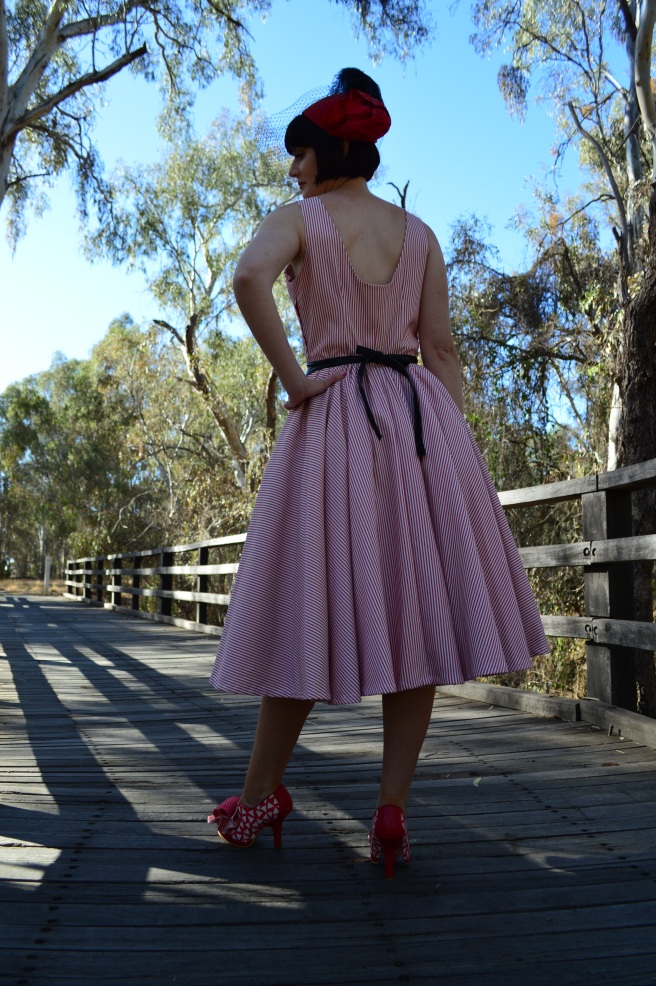
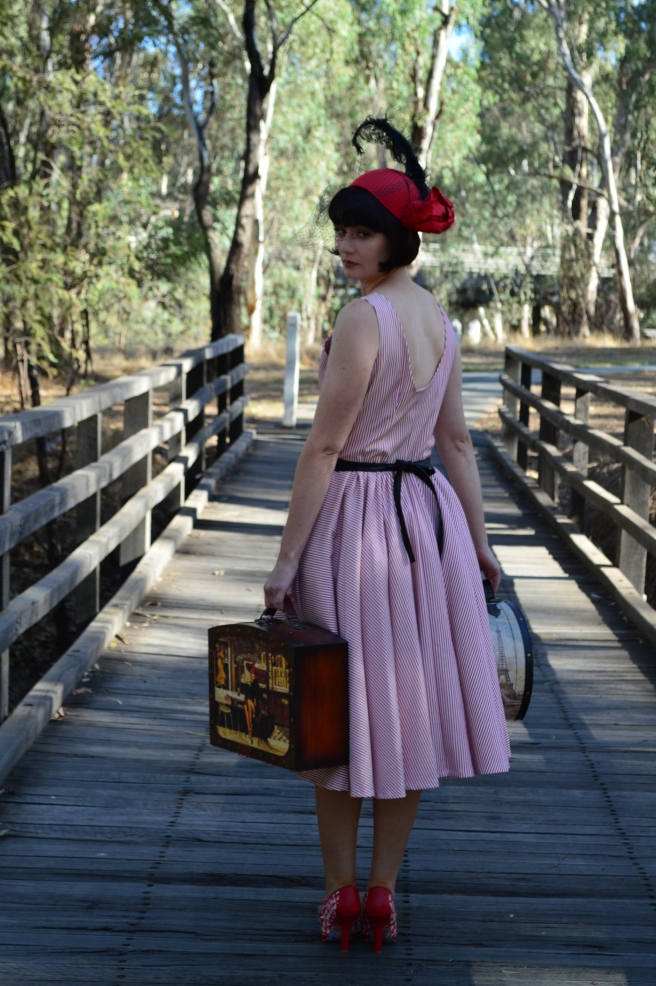
Outfit Two “Mademoiselle Flora” – The most recent piece to my ever growing collection, Mademoiselle Flora is a piece I was commissioned to make for a local art festival. The piece represents the beauty and colour of the rural area which I live in, with its colours evolving from one season to the next. I live in a part of Australia that has four distinct seasons, with the native flora changing dramatically throughout the year. From vibrant yellows and greens in the spring, through to deep and dark winter hues, our landscape forever evolves. Mademoiselle Flora is constructed from a polyester and cotton body, with a nylon netting forming the overskirt and shoulder straps. The floral tribute which flourishes across the dress, has all been made by hand with many hours of work involved. Constructed from wool, cotton and silk, the embellished flowers each have a vintage button centre and have been strategically sew onto the garment. Mademoiselle Flora is overtly feminine, slightly flirtatious and lots of fun. Accessorised by some fantastic emerald green shoes made from patent leather and suede, this ensemble will certainly turn heads and attract appreciation from any true fashionista.
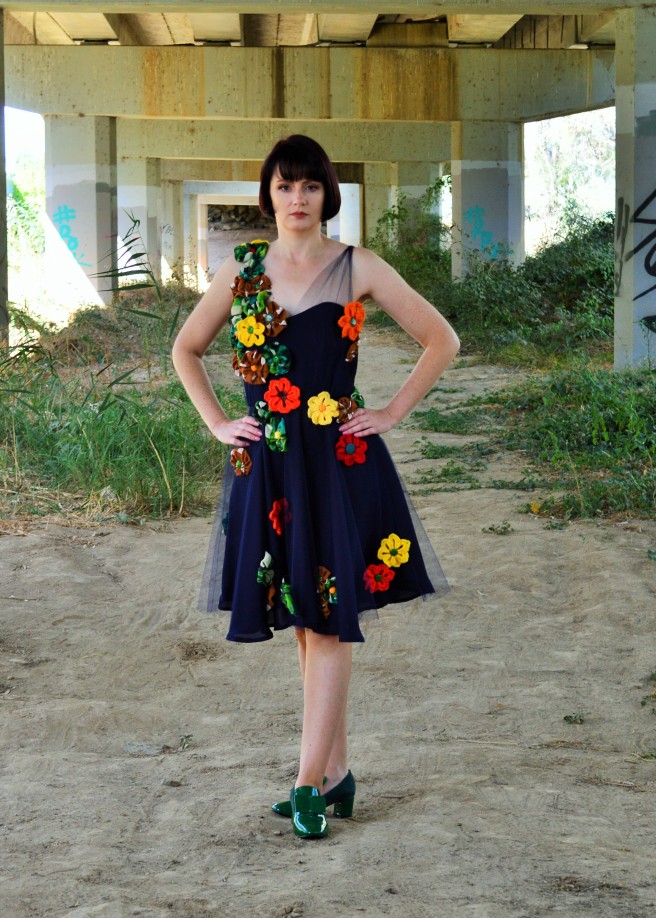
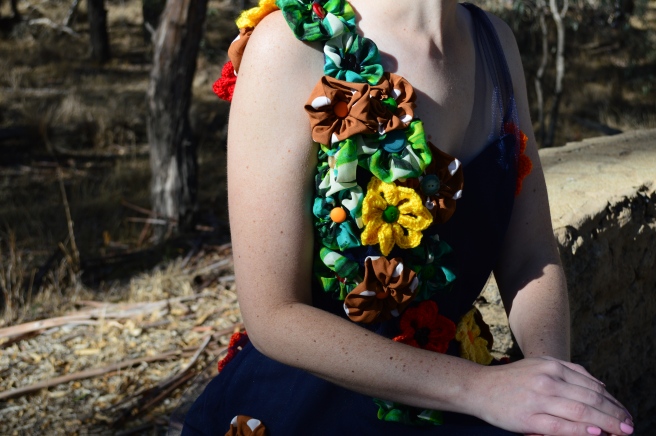
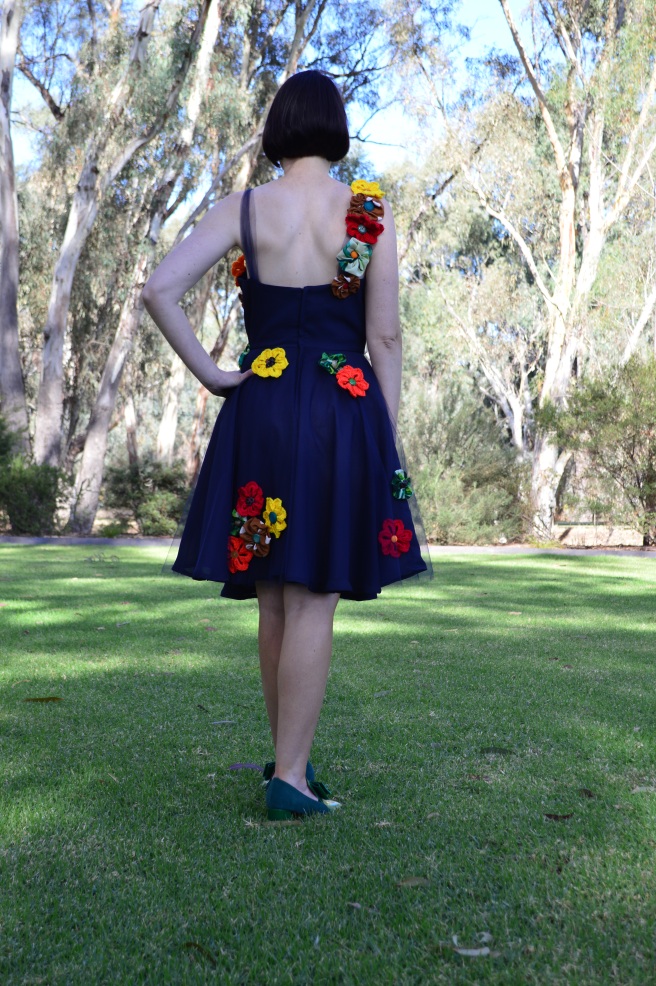
Outfit Three “High Society” – This two piece ensemble is another outfit that I love to wear. The dramatic style of the skirt once again pays tribute to my love of vintage style, but has been constructed in a more modern way. With a wide waist band, the skirt obtains its fullness from separate panels sewn together and pleated at the lower seam line. With hidden hip pockets and a centre back zip, this skirt is so comfortable to wear. The fabric that I used is a cotton blend, with the large floral pattern in a beautiful array of colours, giving the garment an explicitly feminine style. Falling to mid-calf, the length is true to the vintage style that inspired it. The simple yet striking top which accompanies has been produced from a polyester fabric in a deep aubergine hue. The visible metal zipper adds a modern touch to the outfit, as does the crop length with allows the observer to get a full breathtaking view of the skirt, and a slightly sexy vibe to the porcelain skin peeking out from underneath. For this photo shoot I modelled two different style headpieces. The first was purchased from a local fashion business, and was on trend with the boater style hats worn to the Spring Racing Carnival of 2018. In blush pink, this piece tied in beautifully with a clutch of the same tone, and gave the ensemble a slightly French Riviera feel. The second head piece was one I made and wore with the outfit originally. In tones of rose gold, the bandeau style was centred around leather flowers with a pearl centre, gold leaves and black veiling. The aubergine pumps worn with the outfit tie the whole ensemble together perfectly, and give High Society a true Grace Kelly feel.
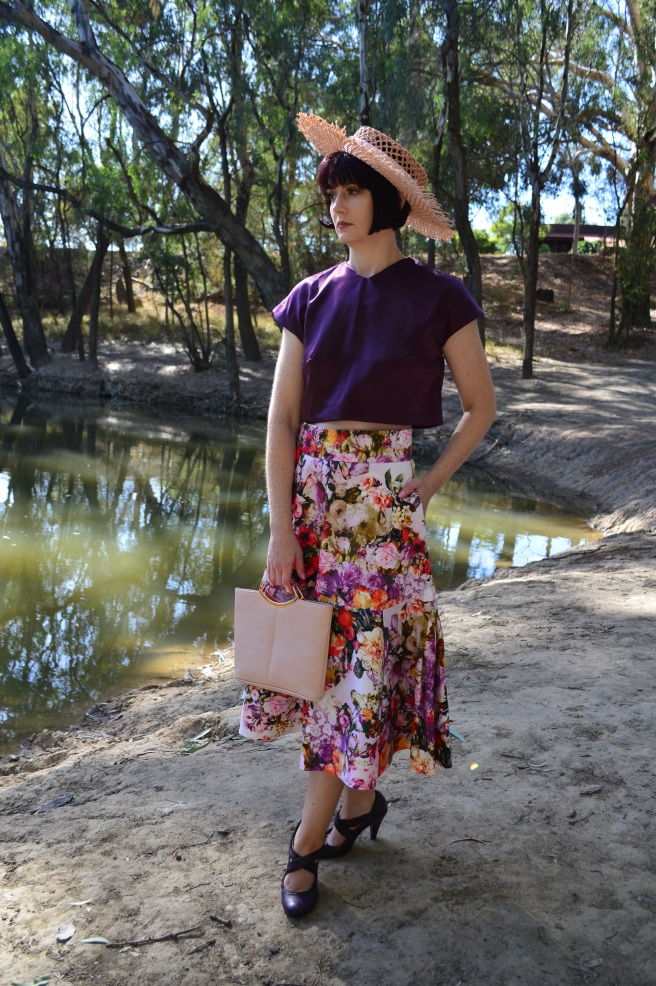
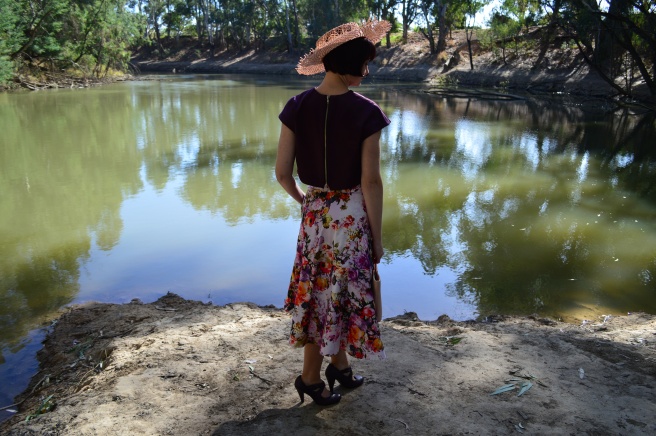
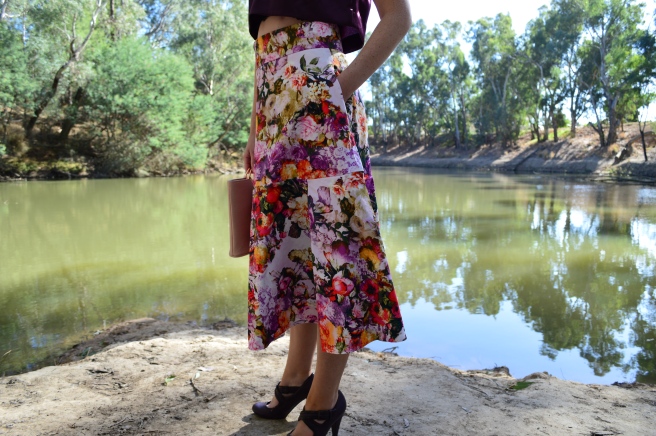
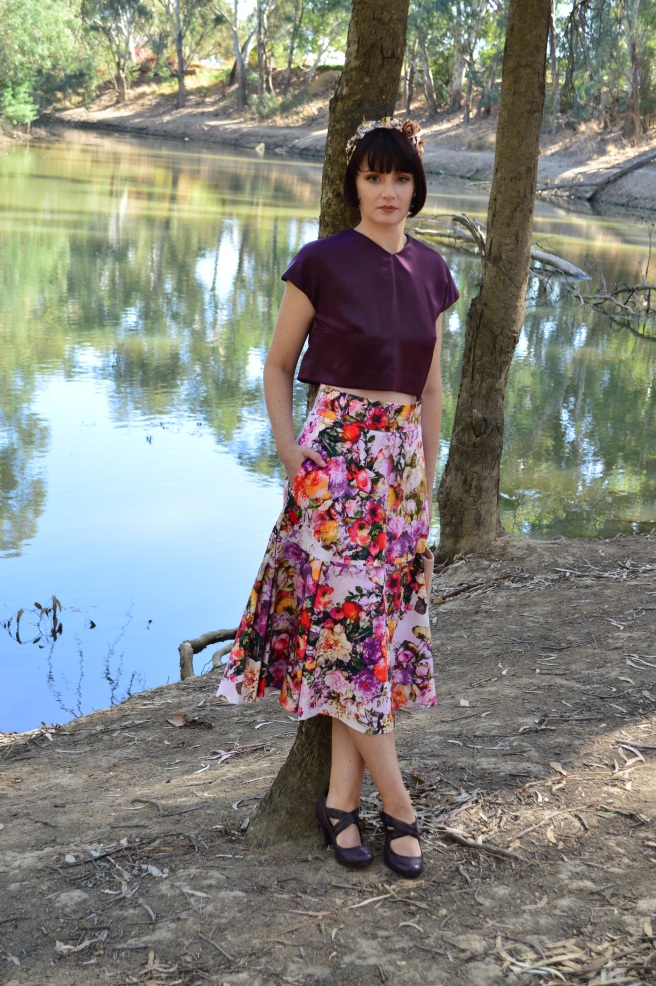
Outfit Four “The September Affair” – Inspired by the flourishing garden displays of the Spring Racing Carnival in Australia each year, The September Affair is another outfit in the Anastacia Rose wardrobe that has a vintage feel to it. Once again it is the fabric that is the real hero of this piece, with the detail on the jacket also making a statement. This design came from a vintage Vogue Pattern from 1951. The original pattern was a one piece dress with a belted waist. I chose to alter it into a two piece ensemble with an extra panel on each side of the jacket to allow for a slightly more relaxed fit. The jacket has a wide turn down collar, and sleeve cuffs that turn up and are held in place by a vintage black and gold acrylic button. The same buttons feature down the length of the centre front opening. Top stitching finishes off the edges of the jacket. The skirt is made up of six separate panels all joined together to give it a flared style. The fabric I used for the skirt is actually a home furnishing fabric and has a ridged texture to it. The stunning floral print in its vibrant spring time hues pay tribute to the blooming roses at Flemington each year. The September Affair is accompanied by a head piece fit for any race day. Made from a sinamay base in matching fuchsia, the piece also incorporates flowers made from the same fabric as the skirt, and perches on the head slightly tilted forward with a hat elastic. To complete the look, a cane bag and tan peep toe block heels were added and give The September Affair a fresh look on a vintage romance.
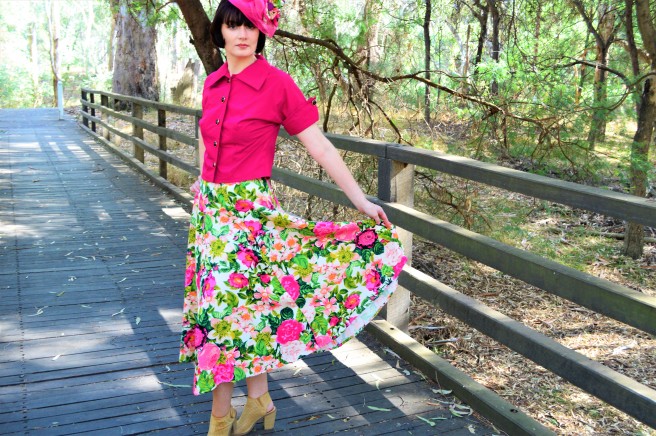
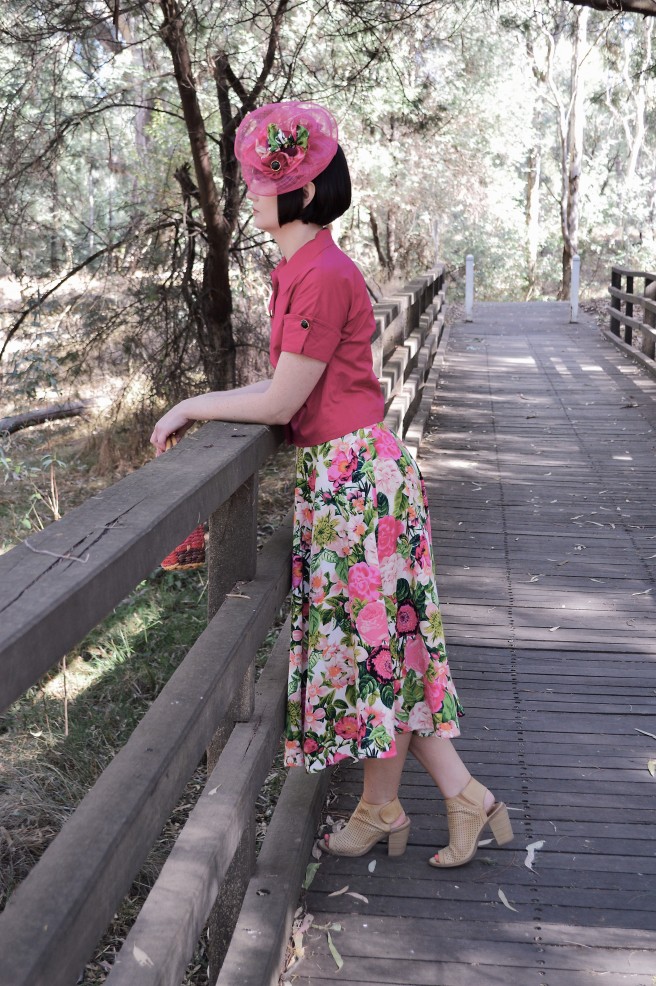

Outfit Five “Midnight in Paris” – The name for this most stunning displays of couture arises from the deep navy silk dupion that it was created with, and a tribute to the grand skill of couture garments born in France. This is a garments that I am most proud of. It was a piece that I designed and produced when I was at university learning the art of handmade luxury. Midnight in Paris was custom tailored to fit me like a glove, with the internal corset structure giving the bodice shape and form. The bulk of the internal layers have been sewn by hand to ensure true fit and great finish. The plunging neck line causes the eye to draw down onto the voluminous skirt below. The cut out back is also a point of difference and shows off the slender spine beneath. With internal metal boing on both the front and back of the bodice, this gown will never go out of shape, or style. The skirt is made from many meters of silk, with layer upon layer of tulle underneath, edges being finished off by silk ribbon. A cotton layer stays closest to the skin to ensure the model has some degree of comfort when wearing such a magnificent ball gown. The pinch effect that covers the skirt was created by literally pinching the fabric together to create a fullness, and hand sewn into position. The centre of these features was finished with a crystal bead. The gown falls long to the gown, has a side encased zip and small covered button on the centre back. Midnight in Paris is not the kind of dress one can easily slip on, and requires an entourage of dresser to assist. But when wearing such a grand ball gown, one should have an entourage in toe! This outfit does not need a gaggle of accessories as her true beauty is more than enough, although a handsome man in a well cut suit would never go astray!
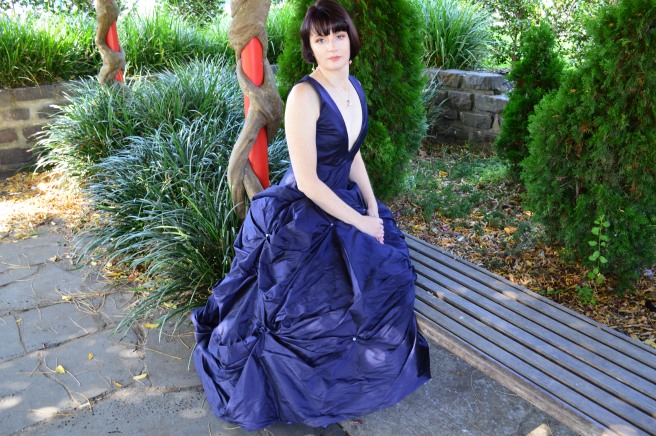
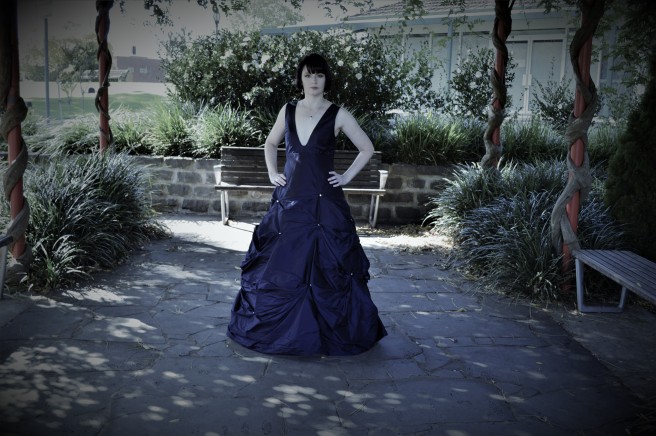
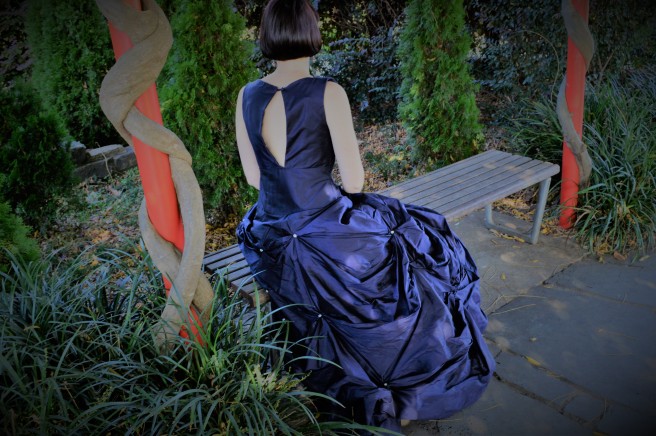
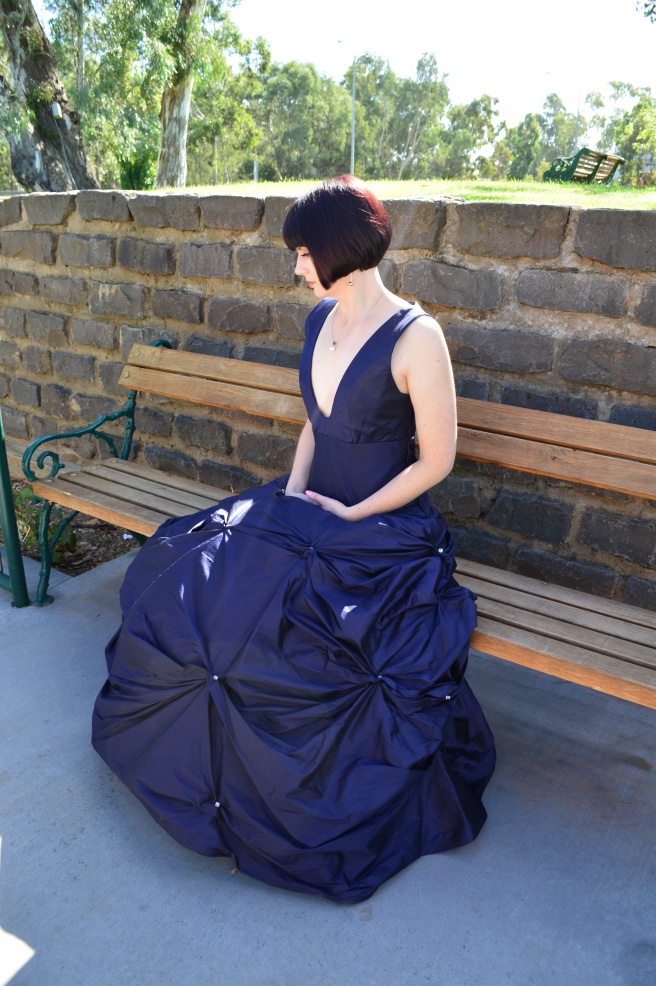
Outfit Six “The Emerald City” – The most recent of pieces added to the collection, The Emerald City is surely a showstopper. The tailored blazer is a striking piece due largely to the glorious fabric in which it is made from. The woven peacock textile with its shimmering golden threads, was a splendid find in an unexpected place. The jacket has both an upper and lower section which allows for better fit and a different design feature. The black silk collar which extends into a front lapel, adds a suave tuxedo feel to the piece, and finishes neatly at the centre front waist. The Emerald City has a hidden talent, showcasing a rich indigo lining which peeps through when the wind blows. With no front fastenings, the wearer may feel exposed if not accompanied by some fabulous under garments. On this occasion, The Emerald City was flaunted with a fitted leather skirt and classic black pumps, but can also be toned down and worn for a more relaxed vibe with denim. Unashamedly sexy and somewhat seductive, this piece is no doubt a knockout!


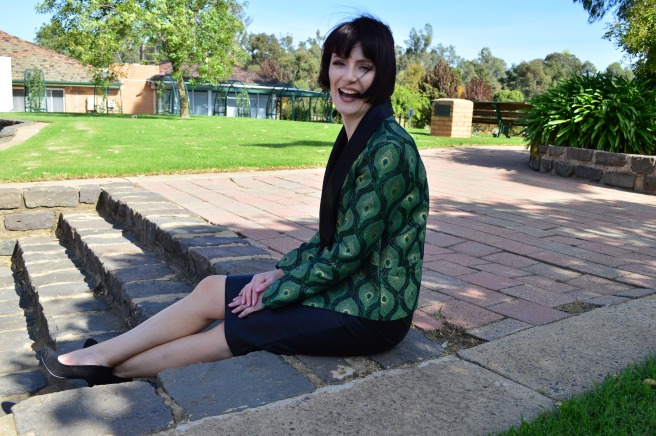
I hope that you’ve enjoyed stepping into the world of Anastacia Rose for an expose on all things fine in fashion. I will forever be influenced by the Golden Age of Couture, by Paris and its art, and by Dior and his ‘New Look’. Fashion is supposed to be fun, it’s supposed to evoke feeling, and I believe it should always be first. Whether you’re at work, at play or doing the supermarket run, one should always try to look their best. Fashion is history, fashion is the future, and fashion is who I am. I’m excited to put my designs and talent on display for all to see, and I hope that you will consider Anastacia Rose when you next need something fabulous to wear. I’ll leave you with one of my favourite quotes – “When you work to please others you can’t succeed, but the things you do to satisfy yourself stand a chance of catching someone’s interest” (Marcel Proust). Always be true to yourself.
Love Always, Anastacia Rose xx




